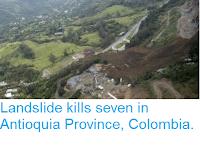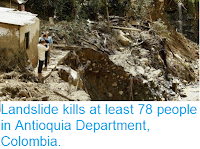Six people are known to have died and it is feared that more people
may be buried, following a landslide in Valle del Cauca Province, Colombia, on Thursday 1 December 2016. The landslide hit a residential district in the city of Cali, destroying a number of homes. The
incident is reported to have happened following a period of heavy rain. Landslides
are a common problem after severe weather events, as excess pore water
pressure can overcome cohesion in soil and sediments, allowing them to
flow like liquids. Approximately 90% of all landslides are caused by
heavy rainfall.
Rescue teams at the site of the 1 December 2016 Cali landslide. Reuters.
Valle del Cauca is a mountainous coastal province with several distinct climate zones. The Cali area is considered to have a tropical climate, with a to peaks
in rainfall in April and October, though there is no completely dry time of year. Two hot wet seasons per year is normal
on the equator, where the Sun is highest in the sky around the equinoxes
and lowest at the solstices, as opposed to the situation at higher
latitudes, where the Sun is highest at one solstice and lowest at the
other.
See also...
Follow Sciency Thoughts on Facebook.







